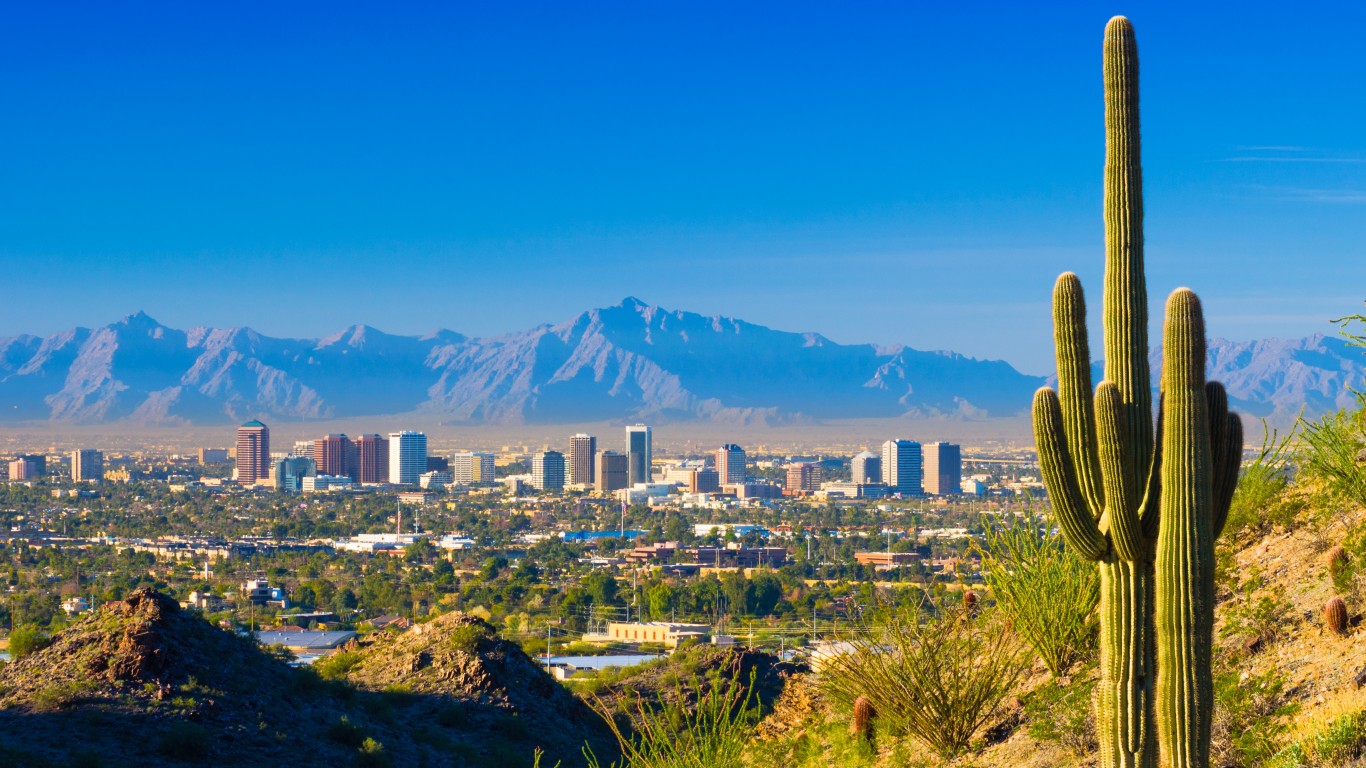Special Report
Income It Takes to Be Considered Rich in Every State

Published:
Last Updated:

Ask 100 people how much money they would need to be rich and you would likely get 100 different answers. “Rich” is a subjective term — and there is no universally agreed upon income threshold. While there is no debate that people such as Oprah Winfrey or Jeff Bezos are rich, determining a base salary that would qualify someone as rich is not as simple. Here is a list of the richest person in every state.
As a relative quality rather than an absolute one, for many, being rich may simply mean having a higher income than the vast majority of other people. According to the U.S. Census Bureau, about half of all U.S. households earn $65,700 or more per year. However, only those households earning at least $131,350 per year are among the richest 20% of households nationwide. But just as median income varies considerably by state, so does the amount needed to be in the richest 20% of households in each state.
To determine the income it takes to be considered rich in each state, 24/7 Wall St. reviewed the minimum income needed to be in the highest earning 20% of households. Data on household income came from the U.S. Census Bureau’s 2019 American Community Survey. In some parts of the country, an annual household income of $94,750 is enough. In others, a minimum household income of over $170,000 is required to rank among the highest earners.
In states where the threshold to be in the wealthiest 20% of households is the highest, the overall cost of living also tends to be high. For example, in Massachusetts, where only households earning at least $171,600 are in the top 20%, goods and services are about 10% more expensive than they are on average nationwide, according to RPP data from the Bureau of Economic Analysis.
Conversely, in states like Arkansas and West Virginia, where a five-figure income can still be higher than what 80% of other households in the state earn, a dollar goes much farther than it does in most other parts of the country. Here is a look at the value of a dollar in every state.
Click here to see how much income it takes to be considered rich in every state.

Alabama
> Annual income needed to be in the top 20% of earners: $106,225 per household (6th lowest)
> Income controlled by highest 20% of earners: 50.5% (21st highest)
> Min. annual income to be in the top 5%: $189,695 per household (6th lowest)
> Median household income: $51,734 (5th lowest)
> Cost of living: 13.6% less expensive than US avg.
[in-text-ad]

Alaska
> Annual income needed to be in the top 20% of earners: $144,736 per household (12th highest)
> Income controlled by highest 20% of earners: 47.6% (4th lowest)
> Min. annual income to be in the top 5%: $242,208 per household (14th highest)
> Median household income: $75,463 (12th highest)
> Cost of living: 4.8% more expensive than US avg.

Arizona
> Annual income needed to be in the top 20% of earners: $120,982 per household (23rd highest)
> Income controlled by highest 20% of earners: 49.7% (25th lowest)
> Min. annual income to be in the top 5%: $220,936 per household (24th highest)
> Median household income: $62,055 (23rd lowest)
> Cost of living: 3.5% less expensive than US avg.

Arkansas
> Annual income needed to be in the top 20% of earners: $98,014 per household (3rd lowest)
> Income controlled by highest 20% of earners: 51.0% (13th highest)
> Min. annual income to be in the top 5%: $176,997 per household (3rd lowest)
> Median household income: $48,952 (3rd lowest)
> Cost of living: 14.7% less expensive than US avg.
[in-text-ad-2]

California
> Annual income needed to be in the top 20% of earners: $162,657 per household (4th highest)
> Income controlled by highest 20% of earners: 52.0% (5th highest)
> Min. annual income to be in the top 5%: $250,000+ per household (the highest – tied)
> Median household income: $80,440 (5th highest)
> Cost of living: 15.4% more expensive than US avg.

Colorado
> Annual income needed to be in the top 20% of earners: $147,217 per household (10th highest)
> Income controlled by highest 20% of earners: 49.3% (19th lowest)
> Min. annual income to be in the top 5%: $250,000+ per household (the highest – tied)
> Median household income: $77,127 (9th highest)
> Cost of living: 1.9% more expensive than US avg.
[in-text-ad]

Connecticut
> Annual income needed to be in the top 20% of earners: $161,063 per household (5th highest)
> Income controlled by highest 20% of earners: 53.4% (2nd highest)
> Min. annual income to be in the top 5%: $250,000+ per household (the highest – tied)
> Median household income: $78,833 (6th highest)
> Cost of living: 6.1% more expensive than US avg.

Delaware
> Annual income needed to be in the top 20% of earners: $134,594 per household (15th highest)
> Income controlled by highest 20% of earners: 48.7% (14th lowest)
> Min. annual income to be in the top 5%: $235,059 per household (18th highest)
> Median household income: $70,176 (16th highest)
> Cost of living: 1.2% less expensive than US avg.

Florida
> Annual income needed to be in the top 20% of earners: $117,017 per household (21st lowest)
> Income controlled by highest 20% of earners: 51.9% (6th highest)
> Min. annual income to be in the top 5%: $226,319 per household (22nd highest)
> Median household income: $59,227 (17th lowest)
> Cost of living: 0.6% more expensive than US avg.
[in-text-ad-2]

Georgia
> Annual income needed to be in the top 20% of earners: $122,832 per household (21st highest)
> Income controlled by highest 20% of earners: 51.4% (7th highest)
> Min. annual income to be in the top 5%: $233,979 per household (19th highest)
> Median household income: $61,980 (22nd lowest)
> Cost of living: 7.0% less expensive than US avg.

Hawaii
> Annual income needed to be in the top 20% of earners: $153,431 per household (6th highest)
> Income controlled by highest 20% of earners: 47.5% (3rd lowest)
> Min. annual income to be in the top 5%: $250,000+ per household (the highest – tied)
> Median household income: $83,102 (4th highest)
> Cost of living: 18.1% more expensive than US avg.
[in-text-ad]

Idaho
> Annual income needed to be in the top 20% of earners: $111,822 per household (14th lowest)
> Income controlled by highest 20% of earners: 47.6% (6th lowest)
> Min. annual income to be in the top 5%: $199,218 per household (11th lowest)
> Median household income: $60,999 (20th lowest)
> Cost of living: 7.5% less expensive than US avg.

Illinois
> Annual income needed to be in the top 20% of earners: $137,248 per household (14th highest)
> Income controlled by highest 20% of earners: 51.2% (8th highest)
> Min. annual income to be in the top 5%: $250,000+ per household (the highest – tied)
> Median household income: $69,187 (17th highest)
> Cost of living: 1.9% less expensive than US avg.

Indiana
> Annual income needed to be in the top 20% of earners: $110,606 per household (11th lowest)
> Income controlled by highest 20% of earners: 49.5% (21st lowest)
> Min. annual income to be in the top 5%: $194,407 per household (9th lowest)
> Median household income: $57,603 (14th lowest)
> Cost of living: 10.7% less expensive than US avg.
[in-text-ad-2]

Iowa
> Annual income needed to be in the top 20% of earners: $113,238 per household (17th lowest)
> Income controlled by highest 20% of earners: 48.1% (10th lowest)
> Min. annual income to be in the top 5%: $199,328 per household (12th lowest)
> Median household income: $61,691 (21st lowest)
> Cost of living: 10.8% less expensive than US avg.

Kansas
> Annual income needed to be in the top 20% of earners: $117,303 per household (22nd lowest)
> Income controlled by highest 20% of earners: 48.9% (16th lowest)
> Min. annual income to be in the top 5%: $211,256 per household (23rd lowest)
> Median household income: $62,087 (24th lowest)
> Cost of living: 10.0% less expensive than US avg.
[in-text-ad]

Kentucky
> Annual income needed to be in the top 20% of earners: $103,349 per household (4th lowest)
> Income controlled by highest 20% of earners: 50.8% (19th highest)
> Min. annual income to be in the top 5%: $185,241 per household (4th lowest)
> Median household income: $52,295 (7th lowest)
> Cost of living: 12.2% less expensive than US avg.
Louisiana
> Annual income needed to be in the top 20% of earners: $107,505 per household (8th lowest)
> Income controlled by highest 20% of earners: 52.3% (3rd highest)
> Min. annual income to be in the top 5%: $199,417 per household (13th lowest)
> Median household income: $51,073 (4th lowest)
> Cost of living: 10.9% less expensive than US avg.

Maine
> Annual income needed to be in the top 20% of earners: $111,898 per household (15th lowest)
> Income controlled by highest 20% of earners: 48.7% (15th lowest)
> Min. annual income to be in the top 5%: $202,639 per household (17th lowest)
> Median household income: $58,924 (16th lowest)
> Cost of living: same as U.S. avg.
[in-text-ad-2]

Maryland
> Annual income needed to be in the top 20% of earners: $164,179 per household (3rd highest)
> Income controlled by highest 20% of earners: 49.1% (18th lowest)
> Min. annual income to be in the top 5%: $250,000+ per household (the highest – tied)
> Median household income: $86,738 (the highest)
> Cost of living: 8.4% more expensive than US avg.

Massachusetts
> Annual income needed to be in the top 20% of earners: $171,613 per household (2nd highest)
> Income controlled by highest 20% of earners: 50.9% (14th highest)
> Min. annual income to be in the top 5%: $250,000+ per household (the highest – tied)
> Median household income: $85,843 (2nd highest)
> Cost of living: 9.7% more expensive than US avg.
[in-text-ad]

Michigan
> Annual income needed to be in the top 20% of earners: $115,802 per household (20th lowest)
> Income controlled by highest 20% of earners: 50.0% (24th highest)
> Min. annual income to be in the top 5%: $209,099 per household (22nd lowest)
> Median household income: $59,584 (19th lowest)
> Cost of living: 7.6% less expensive than US avg.

Minnesota
> Annual income needed to be in the top 20% of earners: $138,273 per household (13th highest)
> Income controlled by highest 20% of earners: 48.2% (11th lowest)
> Min. annual income to be in the top 5%: $244,552 per household (13th highest)
> Median household income: $74,593 (13th highest)
> Cost of living: 2.5% less expensive than US avg.

Mississippi
> Annual income needed to be in the top 20% of earners: $94,744 per household (the lowest)
> Income controlled by highest 20% of earners: 52.0% (4th highest)
> Min. annual income to be in the top 5%: $172,337 per household (2nd lowest)
> Median household income: $45,792 (the lowest)
> Cost of living: 14.0% less expensive than US avg.
[in-text-ad-2]

Missouri
> Annual income needed to be in the top 20% of earners: $111,802 per household (13th lowest)
> Income controlled by highest 20% of earners: 49.9% (25th highest)
> Min. annual income to be in the top 5%: $201,541 per household (15th lowest)
> Median household income: $57,409 (13th lowest)
> Cost of living: 11.2% less expensive than US avg.

Montana
> Annual income needed to be in the top 20% of earners: $108,877 per household (9th lowest)
> Income controlled by highest 20% of earners: 49.6% (24th lowest)
> Min. annual income to be in the top 5%: $187,867 per household (5th lowest)
> Median household income: $57,153 (11th lowest)
> Cost of living: 6.7% less expensive than US avg.
[in-text-ad]

Nebraska
> Annual income needed to be in the top 20% of earners: $117,570 per household (23rd lowest)
> Income controlled by highest 20% of earners: 48.0% (9th lowest)
> Min. annual income to be in the top 5%: $203,793 per household (18th lowest)
> Median household income: $63,229 (25th highest)
> Cost of living: 10.5% less expensive than US avg.

Nevada
> Annual income needed to be in the top 20% of earners: $119,790 per household (25th lowest)
> Income controlled by highest 20% of earners: 50.6% (20th highest)
> Min. annual income to be in the top 5%: $221,626 per household (23rd highest)
> Median household income: $63,276 (24th highest)
> Cost of living: 2.5% less expensive than US avg.

New Hampshire
> Annual income needed to be in the top 20% of earners: $145,865 per household (11th highest)
> Income controlled by highest 20% of earners: 48.0% (8th lowest)
> Min. annual income to be in the top 5%: $250,000+ per household (the highest – tied)
> Median household income: $77,933 (8th highest)
> Cost of living: 6.0% more expensive than US avg.
[in-text-ad-2]

New Jersey
> Annual income needed to be in the top 20% of earners: $171,760 per household (the highest)
> Income controlled by highest 20% of earners: 51.2% (9th highest)
> Min. annual income to be in the top 5%: $250,000+ per household (the highest – tied)
> Median household income: $85,751 (3rd highest)
> Cost of living: 15.2% more expensive than US avg.

New Mexico
> Annual income needed to be in the top 20% of earners: $105,652 per household (5th lowest)
> Income controlled by highest 20% of earners: 50.8% (18th highest)
> Min. annual income to be in the top 5%: $192,480 per household (8th lowest)
> Median household income: $51,945 (6th lowest)
> Cost of living: 8.9% less expensive than US avg.
[in-text-ad]

New York
> Annual income needed to be in the top 20% of earners: $151,926 per household (8th highest)
> Income controlled by highest 20% of earners: 54.4% (the highest)
> Min. annual income to be in the top 5%: $250,000+ per household (the highest – tied)
> Median household income: $72,108 (14th highest)
> Cost of living: 16.4% more expensive than US avg.

North Carolina
> Annual income needed to be in the top 20% of earners: $113,302 per household (18th lowest)
> Income controlled by highest 20% of earners: 51.0% (12th highest)
> Min. annual income to be in the top 5%: $213,009 per household (25th lowest)
> Median household income: $57,341 (12th lowest)
> Cost of living: 8.2% less expensive than US avg.

North Dakota
> Annual income needed to be in the top 20% of earners: $121,975 per household (22nd highest)
> Income controlled by highest 20% of earners: 49.1% (17th lowest)
> Min. annual income to be in the top 5%: $220,611 per household (25th highest)
> Median household income: $64,577 (20th highest)
> Cost of living: 9.4% less expensive than US avg.
[in-text-ad-2]

Ohio
> Annual income needed to be in the top 20% of earners: $113,789 per household (19th lowest)
> Income controlled by highest 20% of earners: 50.1% (23rd highest)
> Min. annual income to be in the top 5%: $204,940 per household (20th lowest)
> Median household income: $58,642 (15th lowest)
> Cost of living: 11.6% less expensive than US avg.

Oklahoma
> Annual income needed to be in the top 20% of earners: $107,252 per household (7th lowest)
> Income controlled by highest 20% of earners: 50.9% (17th highest)
> Min. annual income to be in the top 5%: $194,523 per household (10th lowest)
> Median household income: $54,449 (8th lowest)
> Cost of living: 11.6% less expensive than US avg.
[in-text-ad]

Oregon
> Annual income needed to be in the top 20% of earners: $129,218 per household (18th highest)
> Income controlled by highest 20% of earners: 48.6% (13th lowest)
> Min. annual income to be in the top 5%: $229,747 per household (21st highest)
> Median household income: $67,058 (18th highest)
> Cost of living: 1.1% more expensive than US avg.

Pennsylvania
> Annual income needed to be in the top 20% of earners: $124,987 per household (20th highest)
> Income controlled by highest 20% of earners: 50.9% (15th highest)
> Min. annual income to be in the top 5%: $233,467 per household (20th highest)
> Median household income: $63,463 (23rd highest)
> Cost of living: 2.5% less expensive than US avg.

Rhode Island
> Annual income needed to be in the top 20% of earners: $133,423 per household (16th highest)
> Income controlled by highest 20% of earners: 49.5% (20th lowest)
> Min. annual income to be in the top 5%: $235,524 per household (17th highest)
> Median household income: $71,169 (15th highest)
> Cost of living: 0.7% less expensive than US avg.
[in-text-ad-2]

South Carolina
> Annual income needed to be in the top 20% of earners: $112,365 per household (16th lowest)
> Income controlled by highest 20% of earners: 50.9% (16th highest)
> Min. annual income to be in the top 5%: $204,826 per household (19th lowest)
> Median household income: $56,227 (10th lowest)
> Cost of living: 8.9% less expensive than US avg.

South Dakota
> Annual income needed to be in the top 20% of earners: $111,512 per household (12th lowest)
> Income controlled by highest 20% of earners: 47.6% (5th lowest)
> Min. annual income to be in the top 5%: $190,156 per household (7th lowest)
> Median household income: $59,533 (18th lowest)
> Cost of living: 12.1% less expensive than US avg.
[in-text-ad]

Tennessee
> Annual income needed to be in the top 20% of earners: $109,765 per household (10th lowest)
> Income controlled by highest 20% of earners: 51.1% (10th highest)
> Min. annual income to be in the top 5%: $205,063 per household (21st lowest)
> Median household income: $56,071 (9th lowest)
> Cost of living: 10.1% less expensive than US avg.

Texas
> Annual income needed to be in the top 20% of earners: $128,878 per household (19th highest)
> Income controlled by highest 20% of earners: 51.0% (11th highest)
> Min. annual income to be in the top 5%: $241,212 per household (15th highest)
> Median household income: $64,034 (22nd highest)
> Cost of living: 3.2% less expensive than US avg.

Utah
> Annual income needed to be in the top 20% of earners: $132,560 per household (17th highest)
> Income controlled by highest 20% of earners: 47.1% (the lowest)
> Min. annual income to be in the top 5%: $235,835 per household (16th highest)
> Median household income: $75,780 (11th highest)
> Cost of living: 3.4% less expensive than US avg.
[in-text-ad-2]

Vermont
> Annual income needed to be in the top 20% of earners: $120,270 per household (24th highest)
> Income controlled by highest 20% of earners: 48.4% (12th lowest)
> Min. annual income to be in the top 5%: $212,823 per household (24th lowest)
> Median household income: $63,001 (25th lowest)
> Cost of living: 3.0% more expensive than US avg.

Virginia
> Annual income needed to be in the top 20% of earners: $153,003 per household (7th highest)
> Income controlled by highest 20% of earners: 50.5% (22nd highest)
> Min. annual income to be in the top 5%: $250,000+ per household (the highest – tied)
> Median household income: $76,456 (10th highest)
> Cost of living: 2.0% more expensive than US avg.
[in-text-ad]

Washington
> Annual income needed to be in the top 20% of earners: $151,396 per household (9th highest)
> Income controlled by highest 20% of earners: 49.6% (22nd lowest)
> Min. annual income to be in the top 5%: $250,000+ per household (the highest – tied)
> Median household income: $78,687 (7th highest)
> Cost of living: 7.8% more expensive than US avg.

West Virginia
> Annual income needed to be in the top 20% of earners: $97,399 per household (2nd lowest)
> Income controlled by highest 20% of earners: 49.6% (23rd lowest)
> Min. annual income to be in the top 5%: $171,816 per household (the lowest)
> Median household income: $48,850 (2nd lowest)
> Cost of living: 12.2% less expensive than US avg.

Wisconsin
> Annual income needed to be in the top 20% of earners: $117,929 per household (24th lowest)
> Income controlled by highest 20% of earners: 47.8% (7th lowest)
> Min. annual income to be in the top 5%: $202,582 per household (16th lowest)
> Median household income: $64,168 (21st highest)
> Cost of living: 8.1% less expensive than US avg.
[in-text-ad-2]

Wyoming
> Annual income needed to be in the top 20% of earners: $120,196 per household (25th highest)
> Income controlled by highest 20% of earners: 47.2% (2nd lowest)
> Min. annual income to be in the top 5%: $199,944 per household (14th lowest)
> Median household income: $65,003 (19th highest)
> Cost of living: 7.3% less expensive than US avg.
If you’re one of the over 4 Million Americans set to retire this year, you may want to pay attention. Many people have worked their whole lives preparing to retire without ever knowing the answer to the most important question: am I ahead, or behind on my goals?
Don’t make the same mistake. It’s an easy question to answer. A quick conversation with a financial advisor can help you unpack your savings, spending, and goals for your money. With Zoe Financial’s free matching tool, you can connect with trusted financial advisors in minutes.
Why wait? Click here to get started today!
Thank you for reading! Have some feedback for us?
Contact the 24/7 Wall St. editorial team.